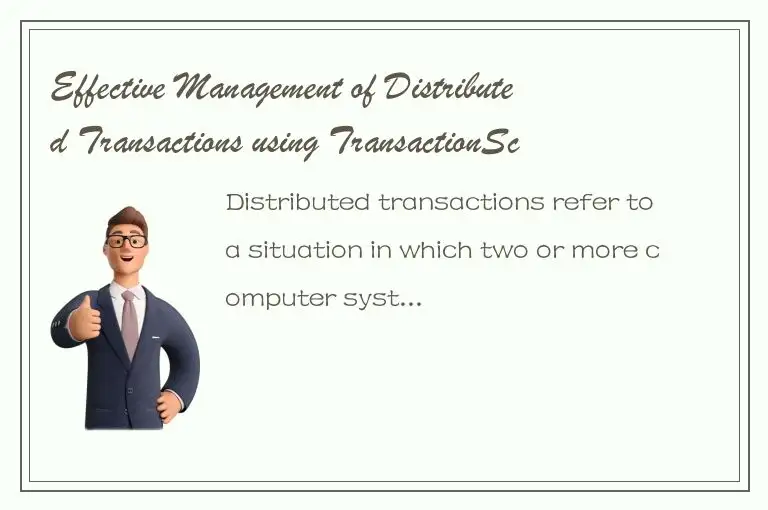Distributed transactions refer to a situation in which two or more computer systems need to work together to accomplish a single task, and each system requires a distinct transaction. For example, when a customer places an order on an online shopping website, the website must interact with a payment gateway to process payment, with a shipping provider to fulfill the order, and with the inventory management system to update stock levels. Each of these interactions involves a separate transaction.

Handling these complex distributed transactions can be challenging because unexpected failures or errors may occur along the way. To ensure consistency and reliability in such scenarios, developers can use a .NET framework called TransactionScope.
TransactionScope is a class in the System.Transactions namespace that provides developers with a simple, coherent programming model for coordinating distributed transactions. Transactions can be created within a TransactionScope object, which automatically manages the lifetime of the transaction and the resources involved, such as databases or web services.
Here are three key benefits of using TransactionScope for managing distributed transactions:
1. Atomicity: An atomic transaction behaves as a single, indivisible unit of work. Either all of the operations within the transaction will succeed, or none of them will. This ensures that the system remains consistent even in the face of errors or failures. In .NET, a transaction is atomic by default when created inside a TransactionScope object.
2. Isolation: Transactions executing concurrently may interfere with one another by reading or modifying the same data. Isolation ensures that each transaction sees a consistent view of the system while it is executing, without being affected by concurrent transactions. TransactionScope provides four levels of isolation, from the weakest (ReadUncommitted) to the strongest (Serializable).
3. Durability: Once a transaction has committed, its changes must be permanently recorded in the system, ensuring that they are not lost in case of a power failure or a crash. TransactionScope guarantees that all resource managers involved in the transaction commit or rollback reliably, ensuring that data is not lost or corrupted.
Now, let’s take a closer look at how TransactionScope works in practice. Consider an online shopping website that must process a customer’s order and payment, and update inventory records. To achieve this, we can use three transactions, one for each task, and encapsulate them within a TransactionScope:
```
using (var scope = new TransactionScope())
{
// Perform order processing
// ...
// Perform payment processing
// ...
// Perform inventory update
// ...
scope.Complete();
}
```
By creating a TransactionScope object and wrapping the transactions inside it, we can ensure that all of the operations are atomic, isolated, and durable. If any of the tasks within the scope fail for any reason, the entire scope will roll back all operations to their original state, thus leaving the system consistent.
It should be noted that TransactionScope requires resource managers to support the Distributed Transaction Coordinator (DTC) protocol. Resource managers include databases, message queues, web services, and other systems that participate in the transaction. DTC provides a way for these resource managers to coordinate their actions and share information about the transaction state.
In conclusion, TransactionScope is an effective tool for managing distributed transactions in .NET applications. By providing developers with a simple model for atomicity, isolation, and durability, it allows them to focus on the business logic of their applications rather than low-level details of transaction management. With TransactionScope, developers can ensure that their systems remain consistent and reliable, even in the face of unexpected errors, failures, or interruptions.




 QQ客服专员
QQ客服专员 电话客服专员
电话客服专员